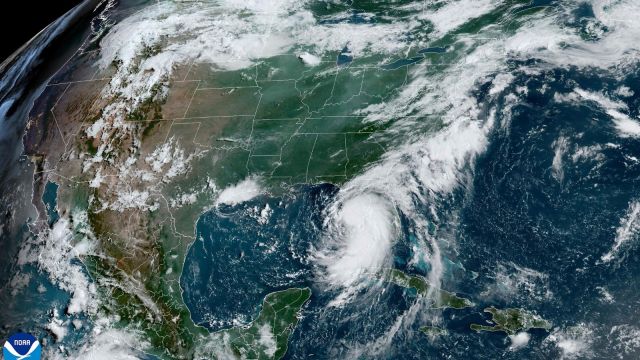Stay updated with the latest - Click here to follow us on Instagram
Tropical storm Debby intensifies, heading towards Florida with potential for record-breaking rainfall
A hurricane warning was issued for parts of the Big Bend and the Florida Panhandle, while tropical storm warnings covered Florida’s West Coast, the southern Florida Keys, and Dry Tortugas.
 This satellite image provided by NOAA shows Tropical Storm Debby as it moves through the Gulf of Mexico toward Florida. (AP)
This satellite image provided by NOAA shows Tropical Storm Debby as it moves through the Gulf of Mexico toward Florida. (AP) As Tropical Storm Debby barreled through the Gulf of Mexico, it rapidly gained strength and was predicted to become a hurricane, posing a threat to Florida by Sunday.
The National Hurricane Center in Miami predicted Debby would reach Category 1 hurricane status before making landfall in the Big Bend region of Florida on Monday.
The storm is expected to move eastward over northern Florida and stall over Georgia and South Carolina, bringing potentially historic rainfall and catastrophic flooding starting Tuesday and lasting through Friday, warned Dwight Koehn, a meteorologist from the National Weather Service in Charleston, South Carolina.
The hurricane center warned that coastal regions, including Savannah, Georgia; Hilton Head, South Carolina; and Charleston, South Carolina, are highly vulnerable to extreme flooding, according to an update issued Sunday at 11 a.m.
 A view shows a warning sign for swimmers, while Tropical Storm Debby approaches the gulf coast in Madeira Beach, Florida, US. (REUTERS)
A view shows a warning sign for swimmers, while Tropical Storm Debby approaches the gulf coast in Madeira Beach, Florida, US. (REUTERS)
Tropical Storm Debby was situated approximately 130 miles off the coast of Tampa, Florida, and 160 miles from Cedar Key, Florida, moving at a pace of 13 mph in a north-northwest direction, with wind speeds increasing to 65 mph from 50 mph earlier in the day.
Governor Ron DeSantis warned Floridians to brace for heavy rainfall, flooding, and potential power outages as Tropical Storm Debby approaches.
In a new measure, flood control devices are being installed at utility stations to minimize power disruptions.
Meanwhile, strong winds and thunderstorms are impacting southern Florida, the Florida Keys, and the Bahamas.
Debby marks the fourth named storm of the 2024 Atlantic hurricane season, following Alberto, Beryl, and Chris, which all emerged in June.
The National Hurricane Center forecasted that Debby would strengthen further as it moved off the southwest Florida coast, where waters are exceptionally warm.
 A couple stands on the John’s Pass Pier, while Tropical Storm Debby approaches the gulf coast in Madeira Beach, Florida, US. (REUTERS)
A couple stands on the John’s Pass Pier, while Tropical Storm Debby approaches the gulf coast in Madeira Beach, Florida, US. (REUTERS)
The National Hurricane Center issued a hurricane warning for the Big Bend and parts of the Florida Panhandle, while a tropical storm warning was put in place for the West Coast of Florida, the southern Florida Keys, and Dry Tortugas.
Meanwhile, a tropical storm watch was issued for further areas of the Panhandle, signaling that storm conditions are likely or possible within the next 36 to 48 hours.
Heavy rainfall of 6-12 inches, potentially up to 18 inches in some areas, is forecasted, leading to severe flash flooding and urban flooding. River flooding is also expected along Florida’s West Coast.
A storm surge of 2-4 feet is predicted for most of the Gulf Coast, including Tampa Bay, with the Big Bend region potentially seeing surges up to 7 feet.
Mandatory evacuations have been ordered for coastal areas in Citrus and Levy counties, while voluntary evacuations have been issued for Hernando, Manatee, Pasco, and Taylor counties.
Citrus County Sheriff Mike Prendergast warned that emergency responders may not be able to reach stranded residents due to storm surge flooding, citing last year’s Hurricane Idalia, which required 73 rescues in the same area.
 A view of the John’s Pass Pier, while Tropical Storm Debby approaches the gulf coast in Madeira Beach, Florida, US. (REUTERS)
A view of the John’s Pass Pier, while Tropical Storm Debby approaches the gulf coast in Madeira Beach, Florida, US. (REUTERS)
As Tropical Storm Debby approaches, Florida Governor Ron DeSantis declared a state of emergency for 61 counties, and the National Guard activated 3,000 personnel to prepare for the storm’s impact.
Meanwhile, Georgia Governor Brian Kemp issued an emergency proclamation.
“I’d urge all Floridians to be cognizant of the fact that we are going to have a hurricane hit the state, probably a Category 1, but it could be a little bit more powerful than that,” DeSantis said in a Sunday morning briefing.
Meanwhile, DeSantis warned that heavy rainfall and flooding are inevitable, and power outages are likely.
However, he said that a new measure is being implemented to reduce the risk of power interruptions: flood control devices are being installed at utility stations for the first time. This, he hopes, will help minimize power outages.”
The White House confirmed that federal and state officials are coordinating efforts, with FEMA pre-positioning resources.
In Tampa, officials distributed over 30,000 sandbags to residents and secured floating cranes and barges in the Tampa Bay area.
Florida State University announced a closure on Monday due to the storm.
Emergency managers in New England and New York closely monitored Debby’s path, concerned about potential flooding in regions still recovering from recent heavy rain.
Vermont Governor Phil Scott expressed concern about additional flooding, as the state continues to recover from July’s storms.
For many, the name Debby evokes memories of the 2012 tropical storm that caused $250 million in damage and eight deaths, including seven in Florida, and delivered 29 inches of rain south of Tallahassee.
(With imputes from AP)





- 01
- 02
- 03
- 04
- 05


























